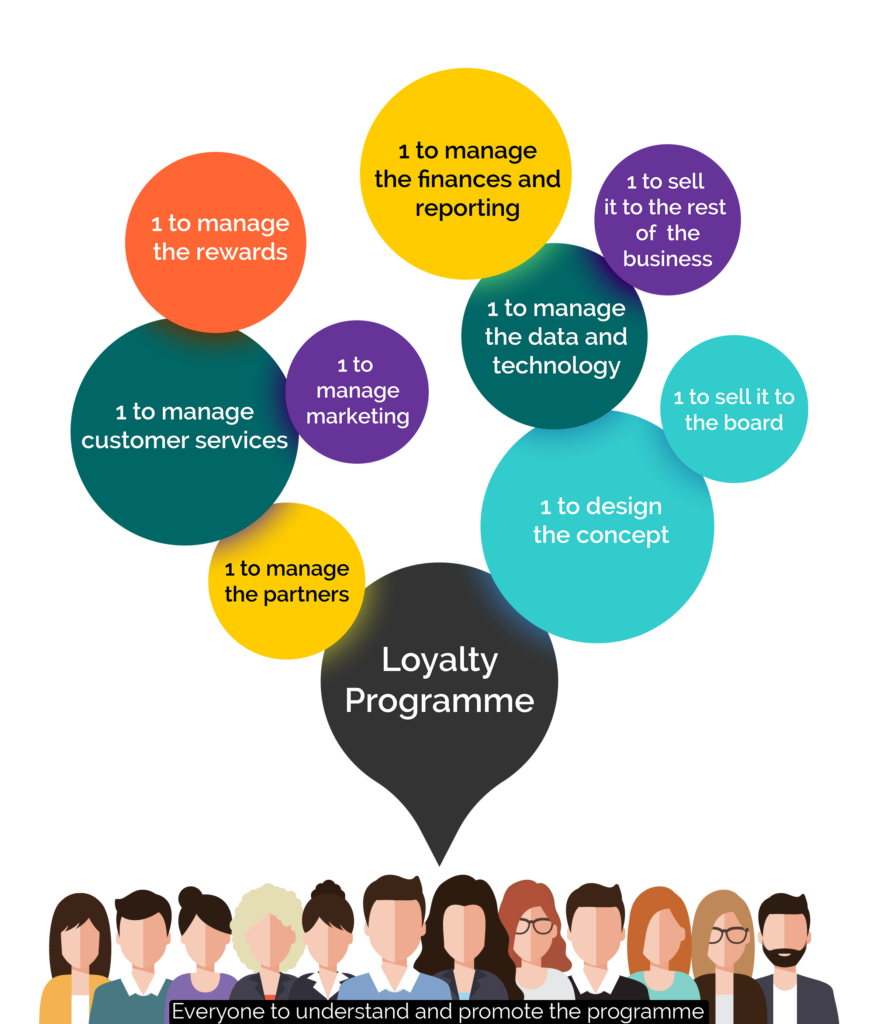We get asked this question a lot, in fact it is one of the first questions new clients ask us. Absolutely a valid question, with most of us time-poor and under-resourced, you need to be sure you have enough people to deliver a loyalty programme effectively.
By: Melanie Parker, CLMP, Stream Loyalty
The answer unfortunately isn’t a simple one. The answer will depend on the size of the business, the number of customers you expect to reach, the type of programme you are running, whether you already have any of these functions in the business and their capacity, and at what stage you are in your journey.
Many poorly thought through loyalty programmes have been shown to fail within the first 2 years and if you want to be confident that yours doesn’t become part of this statistic, you need to make sure that loyalty is embedded, understood, and practiced throughout the business. This means it must be thought through properly, have the ability to evolve, and be appealing to customers and the business. There isn’t any point in having a great customer loyalty programme that your customer facing staff know nothing about or don’t believe in.
While this statistic might be scary, don’t think of it as a blocker, think of it as an opportunity to succeed where your competitors may fail. Think the programme through, have a well thought out roadmap and a clearly defined set of roles, and loyalty will pay for itself a hundred times over.
Loyalty Programme Implementation
Too often we see real issues with project slippage because the programme hasn’t been properly thought through or sold into the business at a financial, operation, and cultural level.
We would highly recommend you have a Loyalty Champion — someone in the business who holds responsibility for the strategy and the vision for the programme. Ensuring you have a clear vision for how the programme is going to work, what its objectives are, what success looks like and how you are going to manage it, is critical to its longevity.
Whilst we would recommend getting people from different functions and departments to provide feedback on elements of the programme as you define them, we would urge caution on accommodating too much involvement or sign off as programmes can easily be derailed with too many people involved.
At the point you start to implement the programme, ensure you have the right people lined up to assist at the right time. Data takes time and is more likely to hold up a programme launch than any other aspect. Get the marketing team involved to start planning communications. Get the sales team involved so they can start to think about how they can weave the messaging into their customer conversations, and make sure your customer service teams have the tools available to help customers when they need to.
Loyalty Programme Launch
This is a crucial part of the programme but shouldn’t need any vastly different resources if you have planned the launch successfully. Think about whether you are going to launch softly or with a big bang. The two options are very different but don’t necessarily require different resource levels. The internal launch is as crucial as the external launch and don’t let it become an afterthought. Ensuring your whole business understands the programme inside and out and is able to live it is crucial to ensuring your customers understand it. We are big advocates of launching a similar programme to your internal audience as well to ensure they feel valued and are able to talk first hand about the benefits.
Loyalty Programme Management
The level of resource you need here very much depends on the type of programme you are launching. Three programmes we run for very different clients are polar opposites in terms of requirements.
The first: a transactional programme that rewards dental practices for purchasing products online with a points bank that they can redeem on future purchases. The programme links in with the company’s e-commerce platform and on a day-to-day level only needs 2 people to manage the programme. Others are involved periodically whether that is for customer service, reporting or financial management, but there are no third party rewards to manage, the technology is managed by Stream Loyalty, and the communications form part of the marketing departments remit in line with the purchasing behaviours. In this case, the technology has been configured to match the programmes needs meaning that less people are required to run the day to day programme and there is the back up of an external agency to manage the reporting, data, and platform. The programme delivered a return on investment in just 6 months and has resulted in over 70% of customers actively purchasing new products.
The second: a community engagement platform for a private education group that rewards their audience for participation in the Club with “money-can’t-buy” resources, events, and experiences. The rewards are delivered in house and by third-party partners and the level of content required for this type of programme is a lot more intense than a transactional programme. The loyalty programme has a minimum of 6 people continuously involved on a day to day basis and we only expect that to increase as the audience expands globally. In this instance there is still a Loyalty Champion, a project manager, marketing and content manager, event manager, and partner manager. Everyone has their distinct roles and fully understands the objectives of the programme.
The third: a branch based trade rewards programme that has gone from strength to strength. In this case, trade installers are rewarded for referrals and purchasing specific products. The business has 3 people internally dedicated to running the programme and then three people from Stream Loyalty who work alongside the team to provide consultancy, strategy, platform development, communications, and customer service. This programme delivered an 80% increase in referrals for the business within the first year and has continued to deliver with over 43% of members changing their buying behaviours as a result.
Final Thoughts
The success of a programme doesn’t depend on the number of people involved in its conception, implementation, or launch. The success depends on the quality and thoroughness of the vision, the clearly defined roadmap, and ensuring that the programme meets both the needs of the audience and the business.
Melanie Parker is a Certified Loyalty Marketing Professional and Director at Stream Loyalty, a UK-based Loyalty Service Provider with clients in England, New Zealand, Australia, France, Spain, Italy, Germany, Switzerland, Canada and the US. She is a Certified Loyalty Marketing Professional and frequent contributor to The Wise Marketer.



